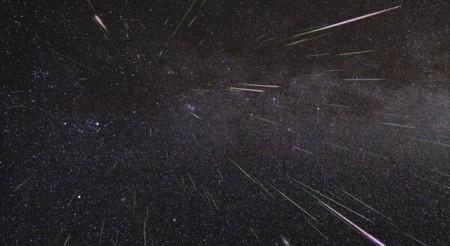
The Geminid Meteor Shower is active in Hawaiʻi through December 19, 2014. The show in the sky began Saturday December 6, 2014. This also coincided with the full moon, thus viewing conditions were not ideal. The waning gibbous moon will provide interference this year throughout the duration of the meteor shower however the moon does not rise until around midnight on the peak nights.
NASA describes the Geminids as the “most reliable annual meteor shower” with up to 100 meteors expected per hour at the peak.
The Geminids are rich in fireball meteors. The American Meteor Society defines a fireball as “a very bright meteor, generally brighter than magnitude -4, which is about the same magnitude of the planet Venus in the morning or evening sky.” They also generally last longer than your typical meteor streak.
According to the Bishop Museum, the Geminid meteor shower is “a rarity in that it is caused by debris from an asteroid (3200 Phaethon) rather than by comet debris.” The Geminids were first discovered in 1862 but astronomers could not find the comet from which they originated. Finally on October 11, 1983 NASA’s Infrared Astronomy Satellite spotted a rocky object in much the same orbit as the Geminid meteoroid and determined this was the source of the Geminids. Just what that “rocky object” is, remains a mystery to astronomers and research into the exact source is ongoing.
Since 3200 Phaethon passes so close to the sun, they named it Phaethon after a Greek mythical character who drove the sun-god Helios’ chariot.
Viewing Tips / Conditions on peak nights
December 12 – 13 (Friday night)
Starting at 9 – 10 p.m. and into the early morning hours
Moon rise: 11:28 p.m. The moon does not set until after noon the next day.
December 13 – 14 (Saturday night)
Starting at 9 – 10 p.m. and into the early morning hours
Moon rise: 12:16 a.m. The moon does not set until after noon that day.
- The moon will be about half-full on both peak nights but doesn’t rise until about midnight. Though the moon will create interference, the brightest meteors will still be visible.
- Meteors are yellow in color and streak across the sky very quickly.
- This shower will appear to radiate from the constellation Gemini but you don’t have to necessarily look directly at the radiant as meteors will appear in all parts of the night sky.
- During the early morning hours, shower activity is combined with normal random meteor activity.
- Dusk is the worst time to view meteors, as the number of meteors that are visible will increase as the night progresses.
- Find the darkest place possible.
- Find an open area where no trees or buildings intrude into your view.
- Allow your eyes to adjust for 15 – 30 minutes.
- Get comfortable. Dress appropriately and lie flat on your back with your feet facing south.


Saturday, July 22nd 2017 at 12:40 pm
Interested in your French vinegerette dressing recipe. I can’t find it in your blog. May I please have your delicious recipe?
Friday, September 8th 2017 at 8:47 am
http://lifesswell.com/foodie-friday-moms-simple-french-vinaigrette-dressing/
HEY Tiana! If you ever want to search for something on my site there is a “search” bar at the top right above the categories Thanks for asking! Aloha, Malika
Thanks for asking! Aloha, Malika